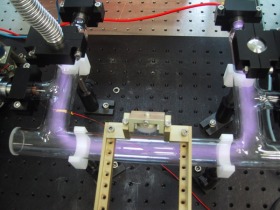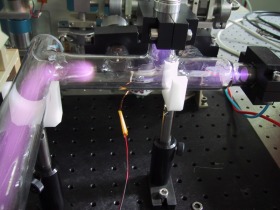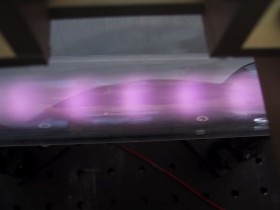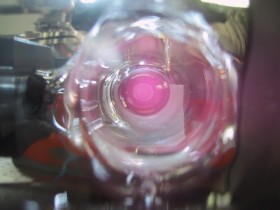 "Plasma crystal (PK) 4"
"Plasma crystal (PK) 4"
A DC-plasma for
the ISS
|
The PK4 (Plasmakristallexperiment 4) project is a continuation
of the successful PKE Nefedov experiment on board the International
Space Station ISS and its successor, PK3 Plus. As with these experiments,
PK4 will allow us to study complex ('dusty') plasmas (made up of ions,
electrons, neutral gas and micron sized 'dust' particles) in a
weightless or microgravity environment. Only under these conditions
stress-free plasma crystal systems can exist and provide us with
unique and new insights into the physics of complex plasmas.
|

Plasma inside PK4 prototype: the 'positive
column' of a DC glow discharge.
|

The dark space inside the 'cathode fall' - left
hand side, the 'positive column' starts.
|
(Note the totally different geometric proportions compared
to the formerly used
RF plasma chambers!)
|
With PK4, for the first time a DC operated plasma chamber
with an observable length of 30 cm and a diameter of 3 cm will be
used to study effects that can not be seen with the PKE Nefedov
and PK3-Plus RF chambers. The main difference of a DC chamber
compared to a RF discharge is the elongated geometry of the chamber
that allows to study more fluid systems than static plasma crystals
like the RF setups. The tubular design provides a high accessibility
for watching and recording the experiment, and also for manipulation
with additional RF fields or intense laser beams. The well known
physics of glow discharges helps to change and to control the plasma
parameters because they mainly depend on pressure, current and geometry.
The effects that are planned to be studied on the kinetic level are:
Laminar and turbulent flow; the transition between both; thermodynamics
and self-organisation of complex plasma flows; solitons and shocks;
interfaces and plasma instabilities; agglomeration and disagglomeration.
For low-frequency excitation and confining particles modulated RF coils
and high-voltage supplies are foreseen.
|

Instability ("Striations") in the PK4 plasma.
|

View into the tube with the plasma.
|
The expected results will be of fundamental interest for the
understanding of complex plasmas, but also for the physics of
condensed matter (crystalization) and fluid dynamics.
Further applications might be in the field of semiconductor
production and astrophysics (planetary formation).
|
Updated: 2004-10-29
Contact: Michael Kretschmer

|